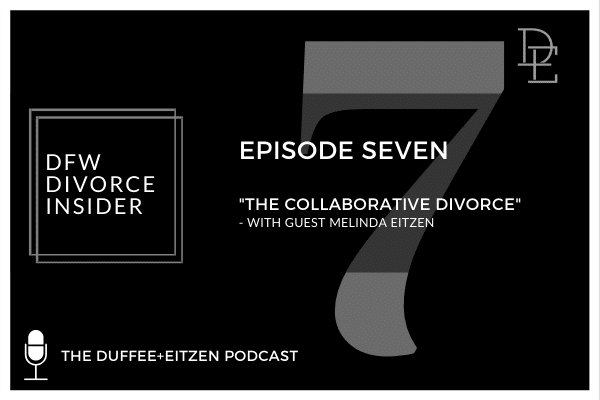DFW DIVORCE INSIDER – Episode 7

- Written by Duffee + Eitzen
- Categorised Divorce
“Prenups Post Nups, and Co-habitation agreements” – with Melinda Eitzen
DFW DIVORCE INSIDER
Podcast Episode 6
D&E Podcast Episode 7
Guest Melinda Eitzen discusses the Collaborative Process
Melinda Eitzen is a credentialed MASTER of collaborative Law, one of only 9 attorney’s with that certification in the DFW area. She also has over 25 years of litigation experience, positioning to help those who opt for a collaborative divorce, and those who chose litigation.
What is the Collaborative Process
It is created by statue in the family code which allows us to have a non-court, more amicable process to help people resolve their dispute- whether it be divorce, post-divorce modifications, pre-nups or post-nups.
col·lab·o·ra·tive
produced or conducted by two or more parties working together.
Working together nicely – it’s a term of art- which means that both parties will not go to court, that the only goal of both lawyers is to help them resolve their differences amicably and SETTLE.
What are the advantages of the collaborative process?
Both parties have to choose this option in order to do it. It is not the default. If one party does not choose it, the default will be litigation.
The 2 parties together chosoe 2 Neutral parties- a mental health professional and a neutral financial professional (both are specifically trained in collaborative). What is powerful about the neutral is the neutral VOICE.
Then the attys have 3-6 two-hour meetings with all of those people at the table.
the clients each state their individual GOALS, sometimes they have overlapping goals (children’s well-being)
Then gather all necessary information (financial info, info about children, etc)
Then they move into option development for settlement (basically brainstorming to determine what combination of options will bring the best result)
Reasons people like the collaborative approach
- Privacy- it is a completely private process. Otherwise courtrooms are open and not private- courtrooms are open, and most filings are public. Privacy is a big reason.
- It allows for more creative solutions- where the judge is limited by the law, in collaborative you are only limited by your imagination- so you can come up with solutions to fit your specific needs and your specific set of facts.
- You get to control your own destiny- for you and your children, rather than have a stranger in a robe decide your destiny.
- Collaborative is less contentious than litigation, allowing both parties to be their higher selves and be more amicable, giving them the chance to be better co-parents after the divorce.
Steps of the Collab Process
One unique feature of collaborative is that you have neutral parties to guide both parties
– a mental health professional – will help both parties deal with anger, sadness, fear that gets in the way of the deal or resolution, leading the team in the meetings. This professional also helps with the parenting plans and decisions around the kids.
- neutral financial professional guides all conversations about money- be it div of the estate, assets and debts, spousal support, paying for the kids moving forward.
What is powerful about the neutral is they are on the side of BOTH parties, so their ideas are not met with suspicion.
What if the two parties can not settle?
Well, while the success rate is 90%, the 10% who cannot do it have to “opt out” for any reason, in writing. When that happens, the parties have to fire their dedicated settlement lawyers and hire new lawyers. For that reason, both clients have the added expense of starting all over with new lawyers, which provides added incentive to arrive at an amicable settlement.
Additional resources to learn more- collaborativedivorcetexas.com
To contact Melinda Eiten: melinda@d-elaw.com

Contact Us